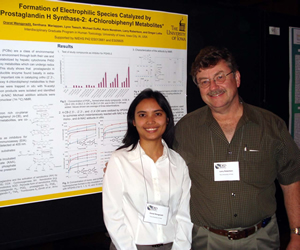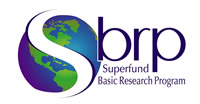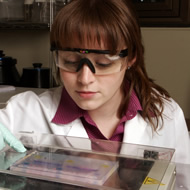
Environmental Factor, January 2009, National Institute of Environmental Health Sciences
Superfund Comes of Age
By Melissa Fabiano-Scheuer
January 2009


The NIEHS Superfund Basic Research and Training Program (SBRP) marked 21 years of research and training success at the Asilomar Conference Grounds in Pacific Grove, Calif. December 7–9. This year’s meeting, “Innovative Science and Technology for Mitigating Human, Ecological and Environmental Risks,” was hosted by the University of California, Davis (UC Davis) and sponsored by the NIEHS.
The meeting convened Sunday evening with the first of two poster sessions. Poster participants included postdocs, researchers and students, with the latter group participating in the annual student poster competition. All posters presented corresponded to Monday’s agenda highlighting SBRP analytical/bioanalytical research and improvements and advancements related to environmental contaminants that comprise the listed Superfund chemicals.
Each of the morning sessions opened with a keynote presentation. On Monday, Arlene Blum, Ph.D., a biophysical chemist and visiting scholar with the Department of Chemistry, University of California, Berkeley (UC Berkeley), discussed “The Fire Retardant Dilemma: Balancing Fire Safety, Human Health and Environmental Protection.” She emphasized the importance of looking at science from past and present perspectives. Blum argued that once individuals take that holistic perspective, they will then have the ability to make more informed decisions about the future.
Blum’s presentation underscored the conference’s central theme — without the knowledge of past scientific research and policy, the reinstallation of dangerous chemicals can endanger the global future. Blum brought this point home as she emphatically stated, “Toxic chemicals could be as threatening to our world as climate change.”
Tuesday morning’s keynote speaker, sociologist Martin Kenney, Ph.D., professor of Human and Community Development, UC Davis, explored the topic, “Is the Mandatory Invention Ownership University TLO [Technology Licensing Organization] the Best Method of University Technology Transfer?”
In his talk, Kenney argued that the United States should reconsider its current position with regard to the ownership of intellectual property derived from publicly-funded research. He highlighted the challenges of the Baye-Dole Act of 1980, advocating that a university-based inventor should own and develop his or her own intellectual property on an individual basis.
Kenney’s keynote presentation was a session topic that was evidently on the minds of many conference participants — indeed, a complete session was dedicated to intellectual property and implications for the university, scientists and business. These talks stemmed from the second Green Technology Entrepreneurship Academy (GTEA), which took place this July (see related story (http://www.niehs.nih.gov/news/newsletter/2008/august/green-technology.cfm)). The session was followed by an interactive panel discussion led by NIEHS SBRP Program Analyst Beth Anderson, which included panelists, entrepreneurs and scientists Raina Maier, Ph.D., Robert Hurt, Ph.D., Rolf Halden, Ph.D., and student 2008 GTEA attendee Collette Quinn.
The second evening poster session Monday evening gave attendees a taste of the next day’s agenda. The focus remained on Superfund chemicals, with an emphasis on their effects on human and environmental health, risk exposure assessments and new applications related to real-world scenarios.
On Tuesday morning, NIEHS Acting Deputy Director William Suk, Ph.D., announced the selection of Laura Senier, a doctoral candidate in the Department of Sociology at Brown University, as the eleventh recipient of the Karen E. Wetterhahn Memorial Award (see Extramural Update in this issue).
Senier highlighted her contributions to Brown University’s SBRP Community Outreach Core in her presentation, "Public Schools and Contaminated Land in Rhode Island: Using SBRP Research Translation and Community Outreach to Foster Research and Advocacy.” This research focuses on the ways translation and outreach activities can engage community groups while supporting policy in public health and environmental justice.
Following Senier’s presentation, Claudia Thompson, Ph.D., acting director of the NIEHS SBRP, presented the Student Poster Awards for outstanding presentations to Stephen Richardson of the University of North Carolina at Chapel Hill (UNC-CH), for Sunday’s session, and Courtney Kozul of Dartmouth College, for Monday’s session.
The meeting wrapped up with closing remarks by Michael Denison, Ph.D., of UC Davis. Denison noted that the meeting had advanced its mission, improving measurement tools for monitoring human and ecological exposure and biological/toxicological effects of Superfund chemicals, and that such advances will facilitate a future of more accurate risk assessment of Superfund chemicals in the present global environment.
(Melissa Fabiano-Scheuer is a communications specialist for MDB, Inc., a contractor for the NIEHS SBRP and the Worker Education and Training Program. She is a regular contributor to the Environmental Factor.)
SBRP Successes
 The SBRP has had many successes during the past 21 years. Several of these accomplishments are listed below.
The SBRP has had many successes during the past 21 years. Several of these accomplishments are listed below.
Kent Udell, Ph.D., University of California-Berkeley SBRP, developed the Steam Enhanced Extraction (SEE) technique for remediation of volatile hydrocarbons from soil. This SBRP-funded research generated a new national and international industry, and provided a technical basis for U.S. Environmental Protection Agency (EPA) policy on source removal for soil and groundwater cleanup.
Michael Denison, Ph.D., University of California-Davis SBRP, developed and validated a rapid and inexpensive recombinant cell bioassay system for the detection and relative quantification of dioxin-like chemicals. The XDS-CALUX® bioassay costs are 40 percent to 70 percent lower than the traditional High Resolution Gas Chromatography/Mass Spectrometry (HR GC/MS) method.
Michael Hooper, Ph.D., University of Washington SBRP, showed that wildlife biomonitoring provides a practical and sensitive means for determining whether the contaminants at hazardous waste sites find their way into the food chain at biologically significant levels. His work supported EPA remediation efforts in Colorado, South Carolina, Kentucky and Washington.
Lucio Costa, Ph.D. and Clement Furlong, Ph.D. University of Washington SBRP, discovered the importance of genetic variability in the human paraoxonase (PON1) gene in determining sensitivity to specific organophosphate exposures. This information provided regulators with data that was important in the EPA's negotiating removal of chlorpyrifos and diazinon from retail sales and home use.
Robert Hurt, Ph.D., Brown University SBRP, engineered prototype sorbent-containing packaging and disposal bags to capture mercury from broken compact fluorescent lamps and/or for use in recycling efforts. Brown University has applied for federal patents covering the mercury-absorption packaging and the absorbent material and plans to begin discussions with companies on manufacturing the new technology.
Josh Hamilton, Ph.D., Dartmouth College SBRP, was the first to report that arsenic is a potent endocrine disrupter and that endocrine disruption is one of the principal means by which arsenic is able to influence a wide array of disease risks, including various cancers, diabetes, cardiovascular disease and developmental problems.
Martyn Smith, Ph.D., University of California-Berkeley SBRP, used detection of genetic translocations in children with acute myeloid leukemia to provide unambiguous evidence of prenatal origin of the disease and suggest that exposures of the fetus before birth could be critical in producing childhood leukemia.
"Wilson and Yakel Honored as AAAS 2008 Fellows..." - previous story ![]()
![]() next story - "NTP Unveils New Non-Cancer Study Criteria..."
next story - "NTP Unveils New Non-Cancer Study Criteria..."
January 2009 Cover Page



